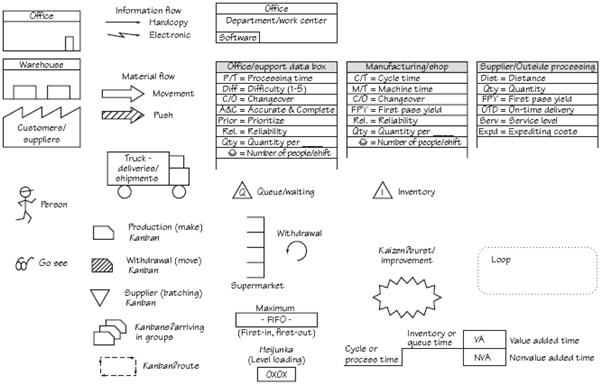8 Simple Steps to Implement Value Stream Mapping (VSM)
VSM is a lean tool that employs a flowchart documenting every step in the process. It is one of the ery important tool that can be used in identifying waste, reducing process cycle times, and implementing process improvement. VSM is a workplace efficiency tool designed to combine material processing steps with information flow, along with other important related data.
This article highlights some 8 simple steps in applying VSM, which are as follows:
 Click Here to Join the Over 280 Students Taking Highly Rated Courses on Quality Assurance/Quality Control, Food Safety, Lean Six Sigma, Lean Manufacturing, Six Sigma, ISO 9001, ISO 14001, ISO 22000, ISO 45001, FSSC 22000, Product Development etc. on UDEMY.
Click Here to Join the Over 280 Students Taking Highly Rated Courses on Quality Assurance/Quality Control, Food Safety, Lean Six Sigma, Lean Manufacturing, Six Sigma, ISO 9001, ISO 14001, ISO 22000, ISO 45001, FSSC 22000, Product Development etc. on UDEMY.
Forming a Team to Create the Lean Value Stream Map
A cross-functional team of high-level managers and supervisors from throughout the company should be formed. Representatives from multiple departments, such as sales, customer service, inventory, operations, and beyond, will help ensure that information can be passed freely back and forth. Adding important suppliers to this group could be considered because an outside perspective can be helpful.
The Kaizen Kick-Off – VSM Planning
Once the team has been formed, your next step is to hold a kaizen (i.e. change for the better in Japanese) event could be held. During this time, team members begin developing current and future plans.
At the kaizen event, the team must complete four important steps: They must
- Determine the process family.
- Draw the current state map.
- Determine and draw the future state map.
- Draft a plan to arrive at the future state.
The Process Family – VSM Planning
A process family, also known as a product family, is a group of products or services that go through the same or similar processing steps. To determine the process family, a matrix similar to the example shown in Fig 2 should be created.

Identify Similarities
Examine the matrix and look for sections that have similar or identical processing steps. Also look for sections that share about 80% of the steps. Consider items that share many of the same steps and procedures that can be created together—by the same workers using similar or related steps—more efficiently in a manufacturing cell. Once you’ve identified similarities, the team must then identify which process family it will concentrate on first.
 Click Here to Join the Over 280 Students Taking Highly Rated Courses on Quality Assurance/Quality Control, Food Safety, Lean Six Sigma, Lean Manufacturing, Six Sigma, ISO 9001, ISO 14001, ISO 22000, ISO 45001, FSSC 22000, Product Development etc. on UDEMY.
Click Here to Join the Over 280 Students Taking Highly Rated Courses on Quality Assurance/Quality Control, Food Safety, Lean Six Sigma, Lean Manufacturing, Six Sigma, ISO 9001, ISO 14001, ISO 22000, ISO 45001, FSSC 22000, Product Development etc. on UDEMY.
Creating the Current State Map – VSM Planning
To create a current state map, collect the data and information by "walking the flow" and interviewing the people who perform the task. The team will have the opportunity to see the entire process and look for waste. The people who actually perform the work (e.g., operators, assemblers, technicians) can answer questions and clarify any misconceptions or preconceived notions on how tasks are performed.
When your team is "walking the flow," the following information should be gotten from employees:
- Cycle time or processing time
- Changeover time
- Reliability of equipment
- First pass yield
- Quantities
- Number of operators and shifts
- Hard copy information
- Electronic information
- Inventory levels
- Queue or waiting times etc.
Start by Creating the Basic VSM Template
Once your team has gathered and reviewed the information obtained while "walking the flow," begins drawing the value stream map.

 Click Here to Join the Over 280 Students Taking Highly Rated Courses on Quality Assurance/Quality Control, Food Safety, Lean Six Sigma, Lean Manufacturing, Six Sigma, ISO 9001, ISO 14001, ISO 22000, ISO 45001, FSSC 22000, Product Development etc. on UDEMY.
Click Here to Join the Over 280 Students Taking Highly Rated Courses on Quality Assurance/Quality Control, Food Safety, Lean Six Sigma, Lean Manufacturing, Six Sigma, ISO 9001, ISO 14001, ISO 22000, ISO 45001, FSSC 22000, Product Development etc. on UDEMY.
Creating the Future State Map
In order to be able to do this, the following questions should be considered.
- What is the takt time? - Takt time refers to how frequently a part or component must be produced to meet customers’ demand. The formula is the time available (per shift) divided by the demand (per shift).
- Are there bottlenecks or constraints?
- Where can inventory (or queue time) be reduced or supermarkets used?
- Where can you improve flow?
- What other improvements are required?

Click Here to Download Readymade Editable Toolkits & Templates on Quality Assurance/Quality Control, Lean Six Sigma, Lean Manufacturing, Six Sigma, ISO 9001, ISO 14001, ISO 22000, ISO 45001, FSSC 22000, HSSE, Project Management etc.
Creating the VSM Draft Plan
The plan will need a refinement, especially in determining resources required, such as time, people, and budgets.
About the Author
Adebayo is a thought leader in continuous process improvement and manufacturing excellence. He is a Certified Six Sigma Master Black Belt (CSSMBB) Professional and Management Systems Lead Auditor (ISO 9001, 45001, ISO 22000/FSSC 22000 etc.) with strong experience leading various continuous improvement initiative in top manufacturing organizations.
You can reach him here.
